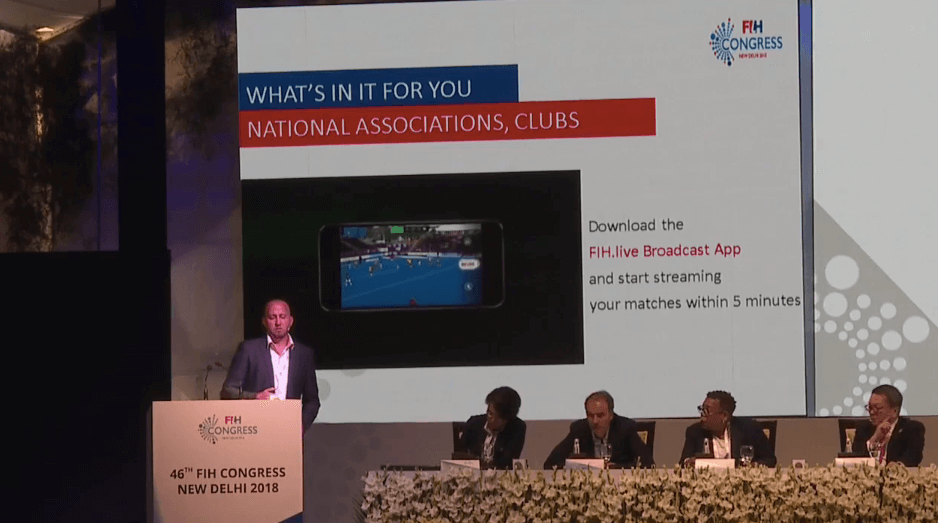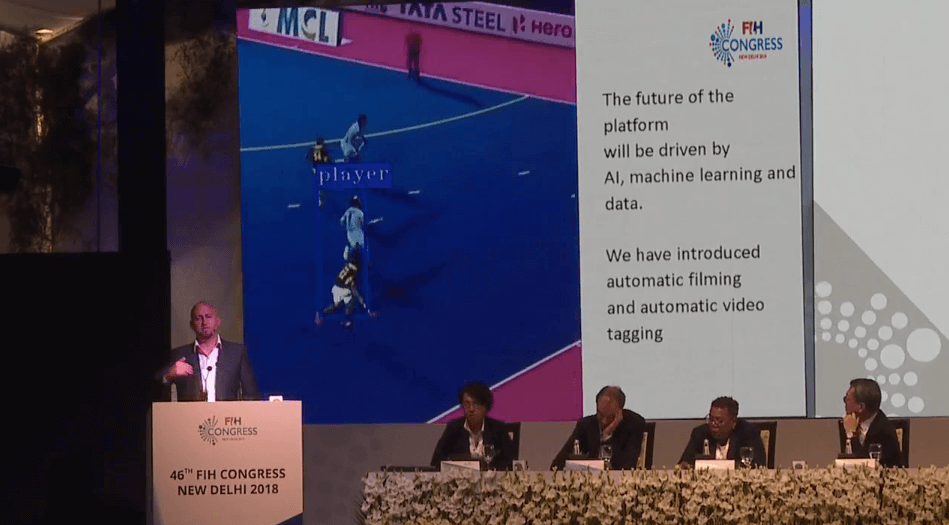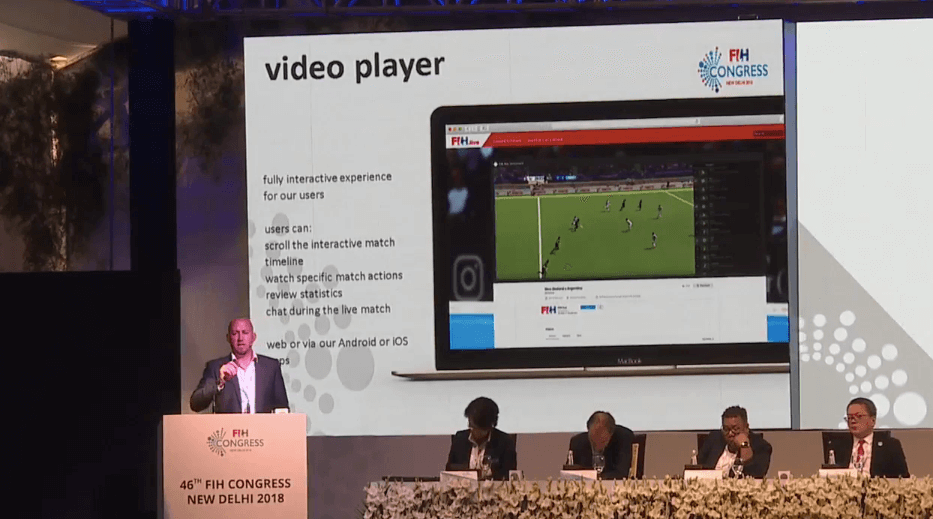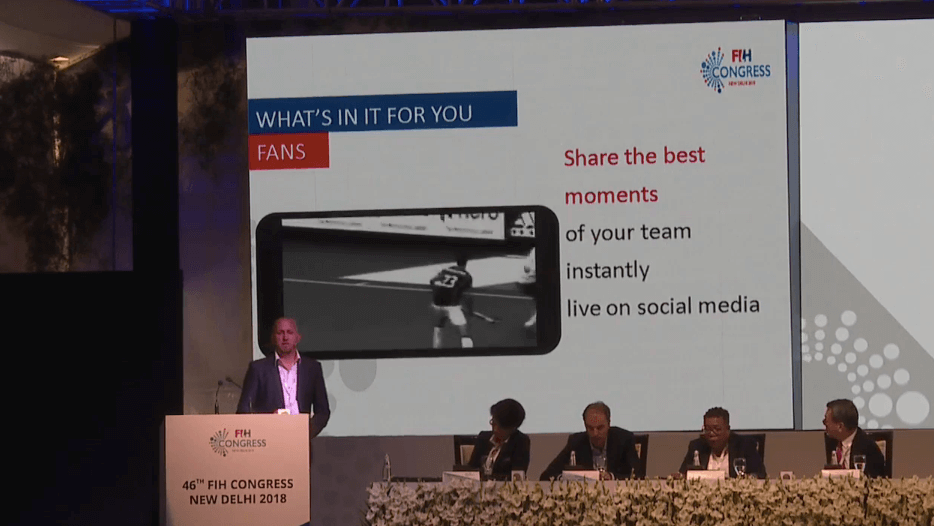A couple of weeks ahead of the World Cup the FIH organised it’s bi-annual congress for all members (= nations) to discuss the state of hockey and their plans for the future. The FIH is halfway their so called 2014-2024 strategy , a.k.a. the “Hockey Revolution”. I’ve written several columns about their strategy and the execution of these plans before. The most recent on entitled “Real revolutions do not follow the downtrodden path“, but the one that got the most attention was one I wrote last summer called “The end of hockey“. So I followed the congress last weekend from beginning to end and will in this and following columns comment on this.
Some highlights from the 2018 FIH congress in New Delhi
There were several remarkable and good decisions announced in New Delhi last weekend. Let’s start with 3 decisions I like…
- hockey can be played on any surface
- some long overdue innovation in the way we show hockey
- and finally development at the heart of FIH’s mission.
But not all is good I fear… The power shift from Europe to Asia. The hype of Hockey5s…
Hockey can be played on any surface!
Finally the attention for sustainability has caught up with hockey and our sport will move away from waterbased artificial turf. Or that’s the plan anyway…
Waterbased turf has added value to our game with more speed and a come back of 3D skills compared to the older generations of turf. However the cost of a waterbased pitch as well as the daily amounts of water needed, a scarce resource in lots of regions, made it a significant hurdle for our sport to grow globally.
[tweet_box float=”none” width=”50%” design=”box_13_at” pic_url=”https://studiohockey.com/wp-content/uploads/Weil-FIH-250×250.png” author=”Thierry Weil – ceo FIH”]At the latest in Paris 2024 hockey will no longer be played on turf with water.[/tweet_box]Thierry Weil, CEO of the FIH, said: “At the latest in Paris 2024 hockey will no longer be played on turf with water” and “Now we will have to work together with manufacturers for turf, ball and shoes to bring you a new experience equal to what we know today on water”.
So the announcement was made up of two elements:
- Turf manufacturers were asked to provide an alternative with the same playing qualities but without water and cheaper before the Paris 2024 Games. It’s a noble goal, but a difficult one… Curious too see how this spins out.
- The FIH will be less restrictive when it comes to the surface for our sport. Hockey can and should be played on almost any surface. So if all participants of an event agree, yes we can play hockey on grass again, or on concrete or gravel or another synthetic surface. However artificial grass will remain the preferred surface for tophockey events…
I think part 2 is a good decision. It will open up hockey to more people. Though at the top there should be consistency when it comes to the surface.
On the other hand for part 1, I question how realistic this goal actually is. Manufacturers have been looking for the right formula to simulate waterbased turf for many years now. I hear doubts from manufacturers about this goal to play on anything else than waterbased turf by 2024…Let’s see what they can deliver! I doubt this goal will be reached, but I like the mindset where hockey can be played on any surface for recreational hockey. I doubt it will have any effect for tophockey.
FIH.live
A very interesting presentation was given about the launch of FIH.live. A new app for smartphones as well as the one centralised platform on internet for our viewing pleasure. So much comes together in the launch of FIH.live that I’ll come back to this later more in depth and just give you some of the bullet points about this. But finally we focus some of this drive for innovation in the way we show the game instead of changing the way we play it. This is the kind of innovation we need/want…
- Geo-blocking finally becomes smart: Of course we still need the income from TV so broadcasters need to protect their content in their territory. But finally the FIH will take back the rights from broadcasters for those games not shown by them and bring these games to the FIH.live platform. So no more frustration for hockey fans around the world who want to see the great nations play each other instead of only their own country.
- Show relevant content: based upon where you live for example you will see more hockey from your part of the world first. But all is available, from games all over the world and from way back when the first games were televised as well.
- User generated content: players, coaches, clubs and federations can all share their content to this one global platform for free.
- Enriched content: the platform will be driven by AI, machine learning and data, lots of data! All kinds of stats can be added to the images, so viewers can not only chat during games with each other, but scroll their interactive timeline for those moments they want to see and learn from the analysis of the game.
- Because the platform will also become the future of video analysis for coaches. No more need for each time to have their own video analyst at every game. When coaches want to review a game being played in a different timezone across the world. They can set their preferred settings and wake up the next morning when the game has played with ready made video clips to review.
- Players and fans can easily share their preferred content on social media, promoting the game.
- The app will be free!
The global launch is set for 2019-01-10 at 13h (GMT) with a full archive of the past and as of that day we can all share our games on this platform as well as enjoy all major events… unless these are being broadcasted in your country of course. And in that case the FIH has promised they will ask more of their broadcasting partners. Not just using our games as standard content, but they will be asked: “Don’t just show hockey. Engage in hockey. Market hockey.”
Promising, promising… Let’s see what they deliver!
Hockey 2024 – growing hockey!
When Thierry Weil reacted to my opinion piece “The end of hockey” from last summer he promised to make a priority of development, meaning growing the participation in hockey, more players and more countries all over the world. He has kept his word!
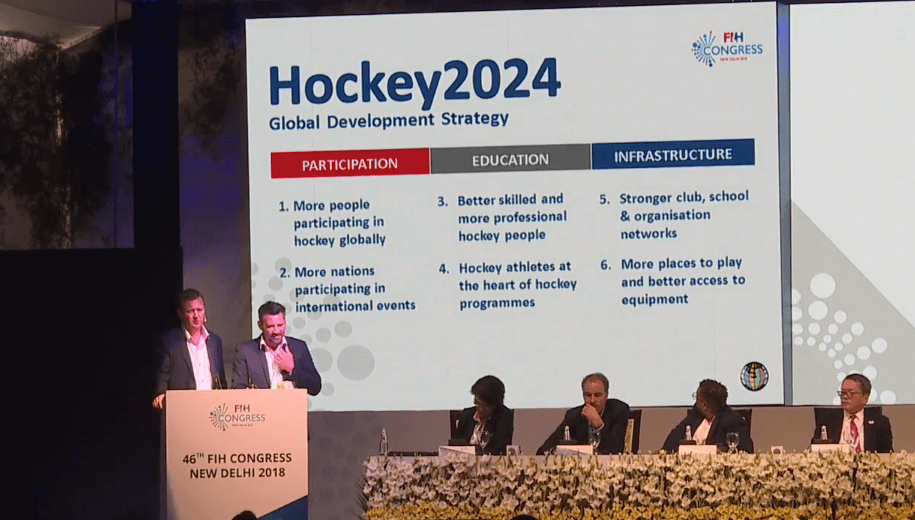 With the launch of “Hockey 2024” at the start of 2019 growing the game is made the number 1 priority for the FIH as it should. This element from the congress too is so comprehensive we will get back to it later more in depth, but to sum up…
With the launch of “Hockey 2024” at the start of 2019 growing the game is made the number 1 priority for the FIH as it should. This element from the congress too is so comprehensive we will get back to it later more in depth, but to sum up…
Hockey 2024 is about more hockey, more participants and more followers! Hopefully in that order 😉 Today we have no global development model. There are lots and lots of initiatives from continental federations, national associations, clubs, organisations and individuals. But there is lack of cooperation and especially a lack of clear data to show if we’re making progress or not.
The new global development strategy will consist of 3 elements, with each two specific goals determined:
- 1. Participation
- More people participating in hockey globally.
- More nations participating in international events.
- Education
- Better skilled and more professional hockey people.
- Hockey athletes at the heart of hockey programmes.
- Infrastructure
- Stronger club, school and organisation networks.
- More places to play and better access to equipment.
This shift in focus towards development at heart of the FIH mission is crucial and therefore good news. We will get back to this in more detail later.
But not all was good that came out of New Delhi last weekend. Let me shed some light on some of the elements that keep me worried as well…
Power shift from Europe to Asia
Elections were on the agenda obviously at such a congress. In Dubai 2 years ago we got a new president for the FIH and for the first time our sport got someone from India at the helm. Batra, previously known for relaunching the Indian federation and especially the Hockey India League took the top spot and he, as expected, proved to be somewhat different from before. New to his role he started off with some unfortunate remarks/mistakes, not becoming for someone in a role meant to unite and promote. When slapped on the wrist by his own federation he became virtually invisible to the rest of the world for most of his “reign” so far and focussed once more on his India, taking up new local responsibilities. Last weekend, presiding the FIH congress he stepped into the global spotlights again… [tweet_box float=”none” width=”50%” design=”box_13_at” pic_url=”https://studiohockey.com/wp-content/uploads/FIH-Batra.jpeg” author=”Dr. Batra – president FIH”]I came to FIH with a very strong agenda to improve the financial situation of FIH. So FIH can help developing nations grow the sport. I intend to put all my effort into that direction.[/tweet_box]The financial reporting at the congress expressed the expectations to grow the revenue from the FIH from more or less 12 million Swiss francs to 16 million when the FIH Pro League starts next year. We’ll have to wait and see. Until now we have not seen much of his promises regarding finances.
Almost all administrators who were instrumental in writing and implementing the global strategy have left the FIH since Batra took over and little over half a year ago Batra appointed a new CEO for our sport with Thierry Weil, a very experienced commercial profile from the world of football. Still somewhat early to judge if this was a good move or not.
But more importantly, for now, is we continue to see a shift of power and decision-making away from Europe towards Asia. As shown from the non re-election of Marc Coudron from Belgium, who is being replaced in the executive board of the FIH by Shahbaz Ahmad from Pakistan.
Guess it’s my European roots speaking here when this worries me. But if you look at the progress and contributions made by Belgian hockey in recent years: strong progress in the ranking and results, strong focus on gender balance, regular and growing media attention for both their domestic as international hockey, quality international event organizers for several years.
And then you turn towards the situation in Pakistan. They have a glorious past, but hardly made any valuable contributions in recent decades. They do not have a (strong) domestic league and struggle to finance their national team at almost every event because they do not have a plan, nor a system in place. No gender equality either. You’ve got to wonder who brings what to the table. Both were once great players for their country, but if we look at track record or accomplishments as an administrator I know who should have been elected.
We’ve seen a growing disregard for the place of our traditional European club hockey by the FIH. We know our club hockey is the foundation of our game in this part of the world and without it any growth or new developments would be built on quicksand. I understand this is different for other regions of the world but when asked if I think what would be best for hockey all over the world: to implement the Asian approach or the European approach. I guess I favour the European club culture and think it would best applied to the rest of the world, adapted to their needs and possibilities of course, instead of the other way around. It may be nice to hear Batra claim he has no problem with European club hockey (the fact he has to confirm this during the congress is already worrying) and I understand culture and situations are different for Asia or Africa. Though I rather see him and FIH actively protecting the tradition of European club hockey. For us and many outside of Europe as well, this club culture is the true foundation upon which the sport of hockey is built. Instead the global hockey family seems to prefer Asian promises over European accomplishments. That worries me… not because it’s Asian over European, but because it’s promises over accomplishments!
The hype of 5s
It baffles me the way Hockey5s is not only hyped but also pushed by FIH. I still see no added value for a second (!) short format of the game, next to the one already existing, “indoor hockey”.
I understand some commercial entities had or have plans to launch a commercial version of Hockey5s. Some even in a mixed version of the game with men and women playing on the same team to attract a new category of sponsors. I have no problems with this kind of event. I probably would like it better if it was more aligned with the existing game. But I understand the reasoning for a commercial entity to do it different. It would give them more freedom to experiment with rules without backlash or resistance to change from those engaged in the existing sport.
This kind of event could even be fun and allow probably for former international players to make some money from their skills when their Olympic ambitions are done and dusted. In that way it could even serve a purpose without bothering or threatening the existing sport.
Alternatively the FIH takes ownership, to prevent a scenario like where FIFA lost their grip on Futsal, but only (!) uses it for bringing the game to the people. This is what they now claim to do. A short format of the game to bring it to inner cities or regions in the world where our standard hockey format is having difficulties taking off for whatever reason.
However the more likely reason is purely commercial. Selling TV rights to bite-sized content for sports broadcasters to fill the gap in their programming. This might be “easy money” but it will never help grow the game of hockey. Let’s learn the lessons of what went wrong in cricket where a commercial short format of the game (T20) was “invented” and pushed. Also claiming it would help grow cricket. Traditional cricket never grew and has suffered even more since T20 pushed aside the existing format of the game. Bigger commercial interests lead to possible/likely more corruption. Is that the way we want to go with hockey?
The move from Hockey India to restart the HIL next year in the 5-a-side format is meant to please broadcasters, not to increase participation in hockey. How will playing this format prepare Indian talent to play the true international game which they claim would still be 11-a-side? The previous concept of the HIL has been instrumental in the return for India on the world stage. Without it India will fall behind once again. Unless obviously 5s will become the Olympic format after all.
Why is the IOC praising Hockey5s at the request of the FIH as shown from the video message at the congress by Bach, the IOC president? A shorter and cheaper format, easier to accommodate for Games in countries without a hockey tradition. Could it be it’s not only meant for exhibition purposes?
How will playing 5s at the YOG help prepare youngsters from those countries for the real game of 11-a-side? Coaches from all over the world have already told us they see little advantage of playing 5s (except for the youngest kids) to prepare for 11-a-side top hockey. So far the only ones singing praise of the 5s format are administrators and some people with commercial interests in it.
Reasons could be because it is a cheaper format for the IOC. It’s cheaper also for those countries with international ambitions but without any interest in club hockey or worthy domestic leagues for both topsport and recreational hockey. If a country has no intention of developing recreational and top hockey, but only focusses on international and commercial, the move to 5s makes sense maybe.
Sure, the FIH claimed once again they and the IOC have no plans to replace 11-a-side hockey by 5-a-side. I think we should not be naive…
Yes, up and until Paris 2024 hockey is guaranteed to stay the same. After Paris there are no guarantees whatsoever…
If FIH truly wanted to continue with 11-a-side they would invest and get the sponsors to promote this format instead of diverting funds and attention to 5s ! Instead they turn down (!) serious money from partners wishing to invest in the Pro League, with the 11-a-side format. And they confirm those interested in setting up a professional event for Hockey5s they will not be supported because the FIH will do this themselves by the end of 2019 and claim to have the sponsors on board for this. Or so I was told…
In just a couple of weeks the FIH Pro League is about to start. Without sponsors, without any real budget to support the original concept. Where India, as the major TV market, backed out. With countries like Pakistan forced upon us by Indian media (who then backed out themselves). But Pakistan can not afford it. The FIH Pro League is set up to fail…
We heard claims India would come back to the Pro League by 2021. And guess what, by that time Hockey5s will be ready to take over. I still believe Paris 2024 might very will be the last Olympics for our game of hockey if we continue on this path.
So when the FIH starts pushing a new format I can’t help but wonder where the hidden agenda is taking them. FIH exists to promote hockey and grow the sport of hockey. In what way will Hockey5s help promote hockey that we could not do with the existing, possibly slightly tweaked, short format of the game. Now attention and means will have to be divided over 3 formats of the game instead of 2. Never a good thing. No, I still think 11-a-side will be pushed aside after Paris 2024. And I do not like it…
Convince broadcasters but especially IOC, we should not sell out our game of hockey to the short attention span of today’s youth. The sport does not exist to make money by pleasing it’s customers. The goal of sport is to contribute to the education of young people to become better adults. Teach them the value of teamwork, dedication and perseverance. Sport is not meant to cater to a decline of attention span, quite the contrary… Do we want our kids to play only shorter and shorter games? Do we want smaller and smaller teams where individuals can make the difference more easily instead of teaching them to work together as a team? Do we want the quick and easy money in betting on this hype or do we go for a long term vision of what we want to achieve and grow our sport from within?
I’ve said it before and will say it again… You have to know the past, to understand the present and predict or plan the future… True in sport as it is in life! That is why I fear for our sport. Without the respect given to domestic hockey (in any shape or form based upon the customs in each region of the world), international hockey will have no future!
Let’s hope I’m wrong 😉
But we should not believe the promises made by these administrators, just because they say so…
The proof of the pudding is in the eating!


